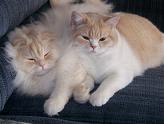|
INTRODUCTION
William Ross, the original discoverer and protector of the first Scottish Folds, once described his fledging breed in
his first unofficial breed standard, as a "family pet, of unknown origin, with a pure white coat, short thick tail, and ears
that folded over like those of a young puppy." In the forty-five years since William Ross first "noticed" his Susie,
his lops and our Folds have been transformed into a flexible-long-tailed, multicolored, multi-patterned, dual-coated, tightly
folded cat, still of mysterious origins, still very much, the devoted family pet. It is the challenge of the breeder
and fanciers of the 2000s, to embrace Ross's dedication, and to continue his lifelong work, to preserve, protect, and to promote
this enchanting mutation from across the seas, as it moves from relative obscurity, to tremendous popularity. Join us,
and become an active part of the growth, prosperity, and the future of this enchanting creature.
PERSONALITY
Scottish Fold are endearing, sweet-tempered, affectionate cats of gentle, friendly disposition. They are quiet,
active, adaptable to all situations, confident, and extremely curious. They are bright, charming, playful devoted companions
for both children and elderly alike. Their fear-no-evil personality, and hug-me-til-I-burst persistence continue to
win this Scot a permanent place in the show hall, and in the home. Because of their patient, gentle, and tolerant nature,
Scottish Folds make ideal therapy cats.
IDEAL APPEARANCE
The Scottish Fold, both shorthair and longhair, is a medium-sized cat, known for its wistful, almost owl-like, facial
expression. Its obvious trademark are its ears which are small and folded downward and forward. The small, tightly
folded double-folded ear is preferred to the larger, loosely folded, single fold. The fold's eyes are large, round,
well-opened, luminous, and should always carry, a look of surprise, or startled innocence. A good fold is ear-resistable
with its adorable face, framed with tightly folded ears, neatly capping its head, with those huge, round eyes begging for
attention. These muscular cats are well-proportioned and balanced, with its head well-rounded, and tended into
a short neck. The tail must always be FLEXIBLE, and in proportion to the body. The tail should never be stiff
or short.
The longhair variety have medium-long, soft, resilient coat, full of life, which stands away from the body. This
coat is non-matting, needing minimal amounts of care. The longhairs carry a full tail plume with pride. Longhair folds
have appeared in Scottish fold litters, since the days of Susie, but were not recognized for championship competition until
the 1990's, and are accepted for championship in all North American feline registries.
The Shorthair Scottish Fold has a short dense resilient coat, with no double coat. The shorthair was accepted for
championship competition by all North American feline registries in the early 1970's. Traditionally, the tabby-whites,
and in particular, the silver tabby-whites have the most popular color in Folds.
THE HISTORY OF THE FOLD
All Scottish Folds trace their ancestry back to the serene hills of central Scotland. There in 1961. a local Scot
shepherd, WIlliam Ross, returning home form a day with his flock, "noticed" in a neighbor's barnyard a white "pixie-faced"
cat with ears bent forward, at play, seemingly unaware of her uniqueness. No one knows if either of Susie's parents
or siblings had folded ears, or how long this ear mutation existed in central Scotland, before being discovered by Ross.
The Rosses eventually acquired one of Susie's folded daughters, a white shorthair, whom they named Snooks. It is from
Susie, through Snooks, that all Scottish Folds, shorthair and longhair alike, trace their parentage, and more importantly
their incompletely dominant mutated ears! Snooks eventually chose for herself a local red male tom cat, and produced
a white folded male kitten, known in our pedigrees as DENISULA SNOWBALL. The Rosses proud of their self-perpetuating
phenomenon, enlisted the help of the cat fancy, and the scientific community.
THE FOLD GENE And GENETIC CONCERNS
It was discovered that although the fold is an extremely hardy cat, the dominant gene that produces the "foldedness,"
can also cause some fusion on the cats skeletal system. This fusion, usually in the tail, only occurs when two folded
cats are bred together. Thus although this gene is non-lethal, and the worst possible outcome can be a stiff or forshortened
tail, sometimes having a crippling affect on the fold adult, all ethical fold breeders since the Rossed have bred their folded
cats to non-folded outcross cats, known as straightears or "perk-ears". Since the 1960's, American Shorthairs, British
Shorthairs, and straightear folds, have been used to guarantee the vigor and health of the fold, diminishing the possiblities
of shortened tails. At birth, all Scottish Fold kittens are born with straightear, no different from any other
kitten. It is not until the twentyfirst day, that those kittens who inherit the folded gene, will fold, while the others
remain normal, straightears. Only folded cats carry the folded gene, and thus in the average fold litter, a third to
a half of the kittens will fold, while the others will remail normal straightear cats. The straightears are just as
endearing, and outgoing as their folded siblings, and make wonderful delightful pets.
Because of the complexity and frustration in dealing with the folded gene, which still today is not totally understood,
breeding, raising, and showing these cats remain quite an endearing challenge, while owning one is a significant pleasure.

|
| Susie, The First Known Scottish Fold |

|
| William & Mary Ross |

|
| Denisla Snowdrift, another early pioneer of the breed |

|
| Denisla Hector, an early pioneer of the breed |
|

